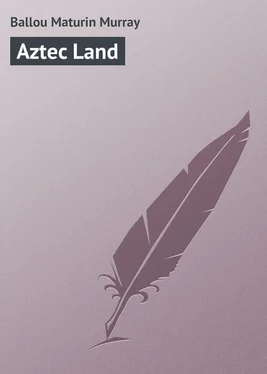Maturin Ballou - Aztec Land
Здесь есть возможность читать онлайн «Maturin Ballou - Aztec Land» — ознакомительный отрывок электронной книги совершенно бесплатно, а после прочтения отрывка купить полную версию. В некоторых случаях можно слушать аудио, скачать через торрент в формате fb2 и присутствует краткое содержание. Жанр: foreign_prose, Путешествия и география, на английском языке. Описание произведения, (предисловие) а так же отзывы посетителей доступны на портале библиотеки ЛибКат.
- Название:Aztec Land
- Автор:
- Жанр:
- Год:неизвестен
- ISBN:нет данных
- Рейтинг книги:4 / 5. Голосов: 1
-
Избранное:Добавить в избранное
- Отзывы:
-
Ваша оценка:
- 80
- 1
- 2
- 3
- 4
- 5
Aztec Land: краткое содержание, описание и аннотация
Предлагаем к чтению аннотацию, описание, краткое содержание или предисловие (зависит от того, что написал сам автор книги «Aztec Land»). Если вы не нашли необходимую информацию о книге — напишите в комментариях, мы постараемся отыскать её.
Aztec Land — читать онлайн ознакомительный отрывок
Ниже представлен текст книги, разбитый по страницам. Система сохранения места последней прочитанной страницы, позволяет с удобством читать онлайн бесплатно книгу «Aztec Land», без необходимости каждый раз заново искать на чём Вы остановились. Поставьте закладку, и сможете в любой момент перейти на страницу, на которой закончили чтение.
Интервал:
Закладка:
There is a very highly prized and remarkable water supply afforded the citizens by an inexhaustible spring, situated in the heart of the town, known as the Ojo de Agua. The cathedral is interesting, though it is not nearly so old as the Church of San Francisco. It was converted into a powder magazine during the war with this country. When General Taylor attacked the city, its remarkably thick walls alone saved it from being blown up, as it was repeatedly struck by shot and shell. Monterey is a finer and better built city than Saltillo. No stranger should fail to visit the curious Campo Santo, a burial place lying to the northwest of the city, and reached by the way of the alameda, which latter thoroughfare is hardly worthy of the name. The few notable buildings in the city are the municipal palace, the state government edifice, and the episcopal palace near the cathedral. All are situated about the Plaza Mayor, or Plaza de Zaragoza as it is called by the people here. A graceful fountain with spouting dolphins occupies the centre, supplemented by two lesser fountains, all very appropriate and artistic. Of the two confiscated convents, one is occupied for a jail, the other as a hospital. It will be remembered that General Taylor, with less than seven thousand men, took the city by storm in 1846, after three days of hard fighting, it being gallantly defended by ten thousand Mexicans under command of General Ampudia. General Worth, who on two occasions led desperate storming parties, was pronounced the hero of the occasion. General Grant, then only a lieutenant of infantry, distinguished himself in the taking of what was known as the Bishop's Palace, but which was in fact a citadel. The Americans carried the citadel by assault, and, planting their guns in position upon its wall, commanded the city, which was forced to surrender. The fighting lasted four days. The Americans lost in killed one hundred and twenty-six, and had three hundred and sixty-three wounded. The Mexicans lost five hundred killed, but the number of wounded was not made public. In recognition of the gallant defense made by the Mexicans, Taylor allowed them to retain their arms and equipments, and when they evacuated the city to salute their own colors.
Resuming our course westward by the way of Jaral, and having arrived at Torreon Junction, a distance of about three hundred and eighty miles from the International Bridge, connection is made with the grand trunk line of the Mexican Central Railroad, which will take us direct to the national capital. This important road extends from Juarez (formerly Paso del Norte), on the Rio Grande, to the city of Mexico, a distance of over twelve hundred miles. It is a standard-gauge road, well built and well equipped, – the growth, in fact, of American enterprise, and really nothing more or less than an extension of the Santa Fé Railroad system. Track-laying began upon this road from both ends of the line in September, 1880, that is, from the city of Mexico and from the Rio Grande at Juarez, and upon the completion of the bridge at La Encarnation, the north and south tracks met, March 8, 1884. The line was formally opened on April 10 following.
From this point southward, towards the mountain city of Zacatecas, we pass through a most uninviting country, where the mesquite bush and the cactus mostly prevail, a region so bereft of moisture as to seem like the desert of Sahara. Here again the cactus is seen in great abundance. As we have intimated, there are several hundred varieties known to botanists, most of which can be identified on Mexican soil, this being their native climate. No matter how dry the season, they are always juicy. It is said that when cattle can get no water to drink, they will break down the cacti with their horns and chew the thick leaves and stalks to quench their thirst. The variety of shapes assumed by this peculiar growth almost exceeds belief; some seen in Mexico assumed the form of trees from forty to fifty feet in height, while others, vinelike, run along the ground bearing leaves as round as cannon balls. Another variety, closely hugging the earth, twists about like a vegetable serpent. The great marvel relating to this plant has been, how it could keep alive and remain full of sap and moisture when other neighboring vegetation was killed by drought. But this is easily explained. It is protected by a thick epidermis which prevents evaporation, so that the store of moisture which it absorbs during the wet season is retained within its circulation. One sort of the cactus known as the cereus grandiflorus blooms only in the night; the frail flower it bears dies at the coming of morning. The cochineal insect of Mexico and Central America is solely nurtured by the native growth of cacti. The yucca palm, fifteen to twenty feet in height, with its large milk-white cluster of blossoms, resembling huge crocuses, dotted the expanse here and there. Occasional flocks of sheep were seen striving to gain a sufficiency of food from the unwilling soil, while tended by a shepherd clothed in brilliant colored rags, accompanied by a dog. Now and then scores of jack-rabbits put in an appearance among the low-growing mesquite bushes and the thick-leaved cactus. These little animals are called jack-rabbits because their tall, straight ears resemble those of the burros or jackasses. The mesquite bushes, so often seen on the Mexican plains, belong to the acacia family. They yield a sweet edible pulp, used to some extent as food by the poorer classes of natives and by the jack-rabbits. The burros eat the small, tender twigs. Indeed, they will apparently eat anything but stones. We have seen them munching plain straw with infinite relish, in which it seemed impossible there could be any nutrition whatever. This is a far-reaching, dreary region, almost uninhabitable for human beings, and where water is unattainable three-quarters of the year. The broad prairie extends on either side of the railroad as far as the eye can reach, ending at the foothills of the Sierra Madre – "Mother Mountains." Here and there, as already instanced, the burial place of some murdered individual is indicated by a cross, before which the pious peon breathes a prayer and adds a stone to the pile, so that finally quite a mound is raised to mark the murdered man's grave. Towards the twilight hour, while we rejoice that our lot has not been cast in such a dreary place, more than one hawk is seen to swoop from its lofty course and fly away with a young rabbit which it will eventually drop and thus kill before it begins to devour the carcase. Thus animals, like human beings, constantly prey upon each other. So prolific are these rabbits that they will soon prove to be as great a nuisance as they are in New Zealand, unless some active means are taken to prevent their increase. The wonder is that the half-starved natives do not make a business of trapping and eating them; but the poor, ignorant peons seem to be actually devoid of all ingenuity or enterprise outside of their beaten track.
CHAPTER IV
Zacatecas. – Sand-Spouts. – Fertile Lands. – A Silver Mining Region. – Alpine Scenery. – Table-Land of Mexico. – An Aged Miner. – Zacatecas Cathedral. – Church and People. – A Mountain Climb. – Ownership of the Mines. – Want of Drainage. – A Battlefield. – Civil War. – Local Market. – Peculiar Scenes. – Native Beauties. – City Tramway Experience. – Town of Guadalupe. – Organized Beggars. – A Noble and Successful Institution. – Market of Guadalupe. – Attractive Señoritas. – Private Gardens.
The first place of special interest on the line of the Mexican Central Railroad after leaving Torreon is Zacatecas, the largest town between the Rio Grande and the city of Mexico, being nearly eight hundred miles south of the river and four hundred and forty north of the capital. Its name is derived from the Indian tribe who inhabited this region long before the coming of the Spaniards. Between Torreon and this city, for a distance of some three hundred miles, as we have described, the country is lonely, prairie-like, and almost uninhabited, forming a broad plain over a hundred miles wide, with ranges of the Sierra Madre on either side. On these dry and sterile plains sand-spouts are frequently seen; indeed, half a dozen were counted at the same time from the car windows. These are created just as water-spouts are formed on the ocean, and to encounter one is almost equally serious. One must visit either Egypt or Mexico to witness this singular phenomenon. As Zacatecas is approached, large flocks of sheep and herds of mules and horses are grouped in the fields, overlooked by picturesquely draped horsemen. The cultivation of the land and its apparent fertility improve, and many one-handled ploughs, consisting of a crooked stick, sometimes shod with iron, are being used. The marvel is that anything satisfactory can be accomplished with such an awkward instrument, and yet these fields in some instances show grand results.
Читать дальшеИнтервал:
Закладка:
Похожие книги на «Aztec Land»
Представляем Вашему вниманию похожие книги на «Aztec Land» списком для выбора. Мы отобрали схожую по названию и смыслу литературу в надежде предоставить читателям больше вариантов отыскать новые, интересные, ещё непрочитанные произведения.
Обсуждение, отзывы о книге «Aztec Land» и просто собственные мнения читателей. Оставьте ваши комментарии, напишите, что Вы думаете о произведении, его смысле или главных героях. Укажите что конкретно понравилось, а что нет, и почему Вы так считаете.












